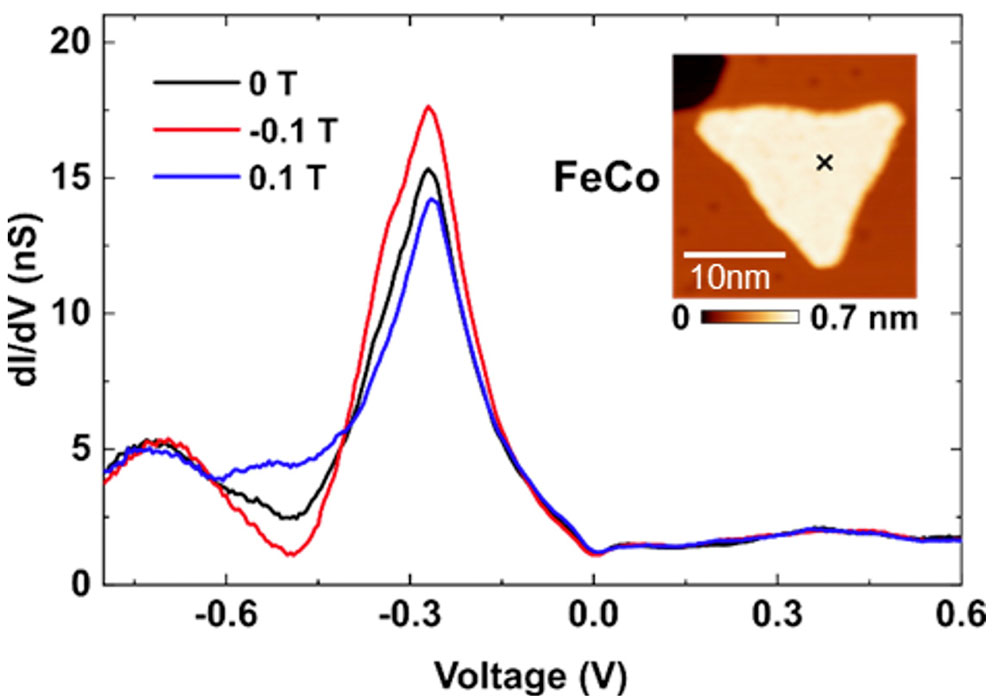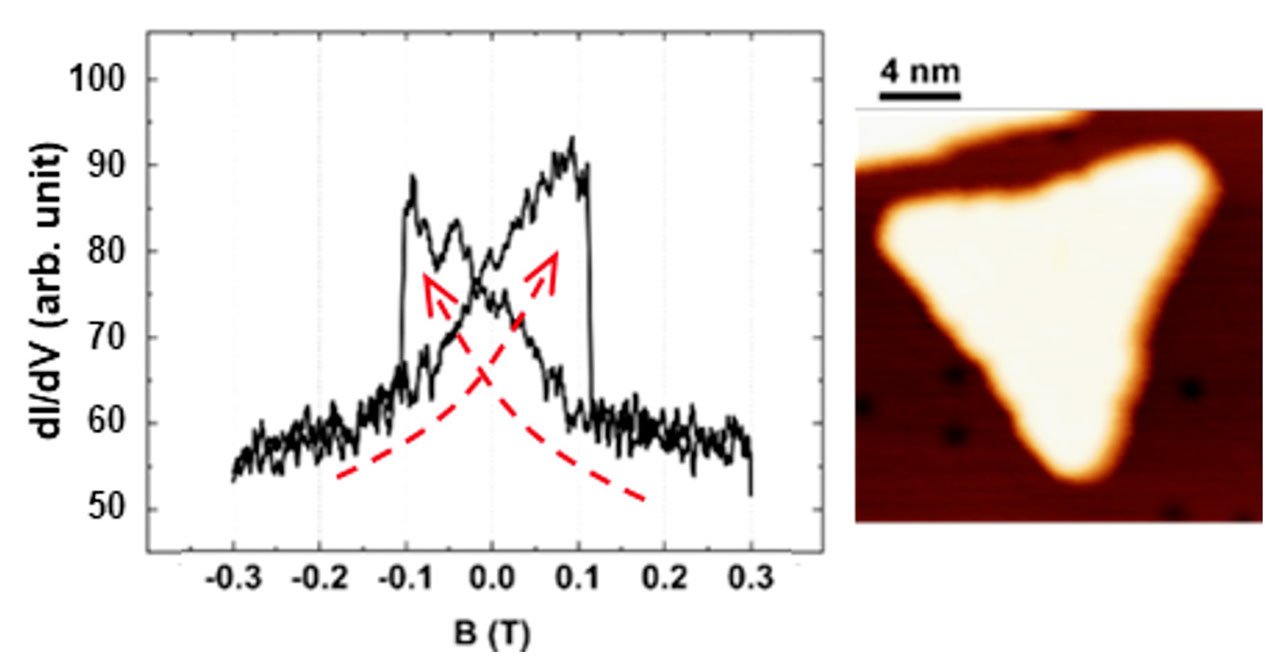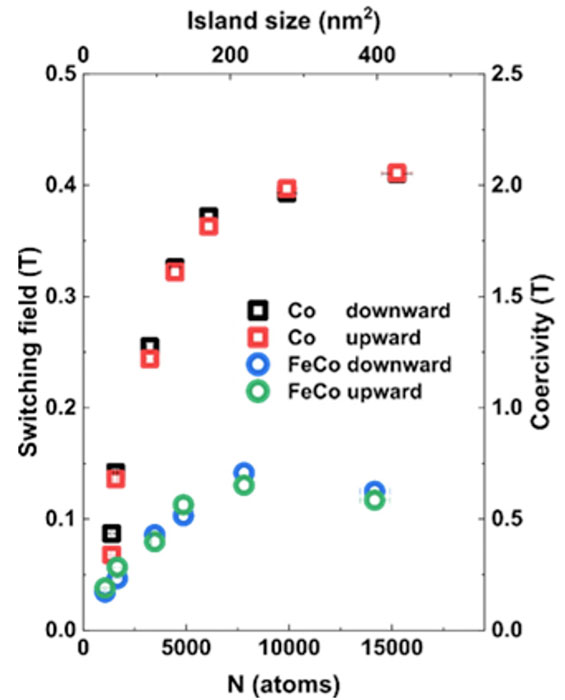Controlling Magnetic Anisotropy of Nano-Size Islands by Alloying
Y. Hasegawa and W. C. Lin
Atomically-thin Fe and Co layers and nano-size island structures formed on the Cu(111) substrate usually exhibit magnetization in the in-plane and out-of-plane directions, respectively. The preferred magnetization directions is due to magnetic anisotropy, and controlling the energy barrier due to the anisotropy are fundamentally important for preserving the magnetization direction and switching it from one of the preferred directions to the other for magnetic storage/recording and spintronics devices.
The magnetic anisotropy basically originates from the spin-orbit interaction, and in the case of the 3d magnetic elements, the magnetic anisotropic energy (MAE) is described with its perturbation. MAE is, therefore, closely related with the occupation/un-occupation of 3d valence bands near the Fermi energy. In the present study using spin-polarized scanning tunneling microscopy (SP-STM) we investigated how the anisotropy and MAE of the 3d magnetic islands can be controlled by adjusting the valence occupation, that is, by alloying the two elements: Fe and Co, which exhibit the contrasting anisotropic behaviors [1].
Figure 1 shows one of the Co50Fe50 islands pseudomorphically grown on the Cu(111) substrate. The thickness of the triangular island is 2 monolayer, and the white bar in the STM image corresponds to 10 nm. Spin-polarized tunneling conductance spectra taken at the marked site with a Fe-coated W tip exhibits a strong peak at the sample bias voltage of -0.3 V (-0.3 eV below the Fermi level). The peak just below the Fermi level has been assigned to 3d minority states of pure Co and the alloy islands. The peak height varies depending on the magnetic field applied in the perpendicular direction. Since the Fe layer coating the probe tip is in-plane magnetized, the applied magnetic field tilts the probe magnetization toward the field direction. The reduction in the -0.3 V peak height, that is, tunneling from the minority states, by a positive (upward) magnetic field indicates upward magnetization of the alloy island. The magnetic field dependence of the tunneling conductance is also found around -0.5 V. The states there are majority ones as they react to the applied field in the manner opposite to the minority ones.

Fig. 1. Spin-polarized tunneling spectra taken at the marked site of a Co50Fe50 island structure presented in the inset STM image. Spectra taken under magnetic fields of 0 T and ±1 T applied in the perpendicular direction to the island are presented. A Fe-coated W tip was used as a spin-polarized probe.
The magnetic response of the tunneling conductance spectra indicates that the alloy island exhibits perpendicular magnetic anisotropy (PMA). In order to make it clear we swept the applied magnetic field and measured the tunneling conductance at -0.3 V. The obtained result is shown in Fig. 2. Gradual increase (decrease) with the increment (decrement) of the magnetic field is due to the tilt of the probe magnetization by the applied field. Then sudden drops observed around ±0.12 T are due to the flip of the magnetization of the alloyed island from anti-parallel to parallel directions to the applied field. From the positions the drops, we can measure switching magnetic field or coercivity, which are closely related with the energy barrier between the two PMA configurations.

Fig. 2. Tunneling conductance at the sample bias voltage of -0.3 V taken at the center of the CoFe alloy island presented in the right STM image during a sweep of the applied perpendicular magnetic field. The sweeping directions are marked with red dashed arrows. Sudden drops of the tunneling conductance indicate switching of magnetization of the island.
The PMA energy depends on the size of the islands; basically proportional to the area or the number of the composing atoms. We measured the switching field on various sizes of the alloy islands, and the results are summarized in Fig. 3 and compared with those taken on pure Co islands. One can clearly find that the switching field of the alloy islands is significantly reduced from pure Co islands by a factor of 3-4. For both Co and CoFe alloy islands, the switching field gradually increases with the size of the islands or the number of the composing atoms, but around 8000 atoms it exhibits saturation or even reduction with the island size. The peculiar behavior of the switching field is explained with a crossover of two magnetization reverse processes; for small islands the magnetization flips at a time whereas large islands are reversed through a process of domain wall nucleation and propagation. It should be noted here that since a ferromagnetic tip is used stray field from the tip significantly reduces the switching field; through the comparison with the switching filed measured with an antiferromagnetic Co-coated tip, which directly provides coercivity, we estimated coercivity of our samples as depicted in the right axis of Fig. 3. Nevertheless, the results presented in Fig. 3 clearly indicate that the switching field is significantly reduced by the alloying, and suggest that the crossover same as pure Co islands also occur on the alloy islands.
References
- [1] H.-H. Yang, C.-C. Hsu, W.-C. Lin, and Y. Hasegawa, Phys, Rev. B 104, 035422 (2021).

